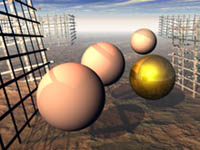![]()
|
Page 1 - Background | Page 2 - Technique 1 - Monocular depth cues Click the image to view the associated monocular depth cues. Get to know them. The Stereographics Glossary also lists these with a bit more theory. 2 - Binocular depth cues Click this image to get to know the binocular depth cue 'Stereopsis'. This image is in cross-eyed viewing format, by the way. |
3 - StereoSpace™ A technically good stereographic picture builds on using these both types of cues effectively. With stereopsis, the more objects you have at different distances, the more levels of depth you have in the stereo image. Diagonal lines extending away from you are very effective. Still, the stereo effect only works within a certain range. You can think of your stereo image as a space, with it's near and far ends. Depending on you stereobase, it's hard to make far away mountains and close-by butterflies look like having depth at the same time. It's a trade-off, a bit like depth-of-field. 4 - Notes on composition Envision your compositions in space rather than on 2D surface. Think of the relations between objects in your image, the distances between them, their positions. When photographing people, note how powerful the direction of their gaze is. What are they looking at ? |

